Summer has ended, blessing us with a bountiful harvest of vegetables. Now, gardeners and homemakers face a new challenge – how to preserve this abundance? Root vegetables and some other crops can last a long time in a dry, cool place, but cucumbers will spoil within days if stored without refrigeration. To prevent this, people have practiced pickling and fermenting cucumbers for centuries. For large quantities, fermenting cucumbers in a barrel is the most practical method.
Table of contents
Advantages and Disadvantages of Barrel-Fermented Cucumbers
Fermenting in wooden barrels has numerous advantages over traditional jar canning: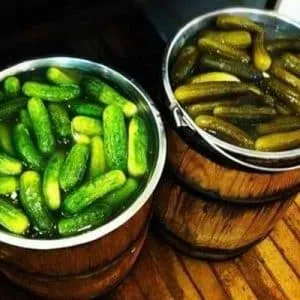
- Simple and relatively easy fermentation process;
- Saves time and effort;
- Quick processing of large vegetable batches;
- Compact storage, saving cellar space;
- Unique flavor and crunch of barrel-fermented cucumbers.
As for the drawbacks, they mainly relate to storage conditions and materials: finding suitable barrels can be difficult, small harvest quantities may not justify the effort, and urban apartments often lack proper storage space.
Note. Barrel-fermented cucumbers are healthier than vinegar-pickled ones. While marinades use vinegar, fermentation relies on natural lactic acid produced during the process, along with the salt brine, acting as preservatives.
Traditional European Barrel-Fermented Cucumbers
The first attempts to cultivate and ferment cucumbers date back to the third millennium BCE in Mesopotamia and India. In Europe, historical records mention barrel-fermented cucumbers as early as the 12th century.
Preparing the Barrel and Cucumbers
Before starting the fermentation process, prepare the barrel properly.
Barrel preparation steps: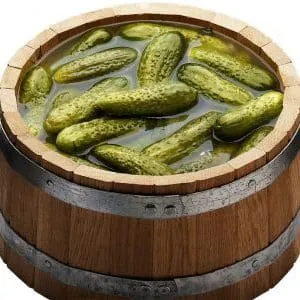
- Thoroughly scrub the barrel with a brush using natural soap or baking soda.
- Rinse abundantly with clean water.
- Sanitize with boiling water. For aroma, add juniper branches to the boiling water.
- Seal the barrel with melted beeswax – this prevents leaks and closes wood pores to avoid unwanted odors.
Once the barrel is ready, prepare the cucumbers:
- Sort cucumbers by size. Smaller ones ferment faster and stay crispier.
- Wash thoroughly and inspect for damage – only flawless cucumbers should be used.
- Trim the ends for better brine absorption and aesthetic presentation.
- Soak in ice water for several hours – this keeps them firm and crunchy during fermentation.
After preparation, choose your recipe and prepare additional ingredients. Wash all herbs, chop larger pieces, and peel and slice garlic and horseradish.
Tip. Use late-season cucumber varieties for fermentation. Ideal barrel cucumbers measure 8-15 cm with underdeveloped seed chambers.
Brine Recipe
A properly made brine is key to delicious barrel cucumbers. While recipes specify salt quantities, the results don't always meet expectations.
Many forget this crucial detail – salt quantity depends on cucumber size:
- Small (4-6 cm) – 6-7 kg cucumbers, 70 liters water;
- Medium (8-10 cm) – 8 kg, 80 liters;
- Large (over 10 cm) – 9 kg, 90 liters.
Hard well or spring water makes ideal brine. For better salt dissolution, slightly warm and stir the solution. Add natural spices to taste: black, allspice, or chili peppers; cherry or oak leaves, dill umbels; garlic cloves.
Step-by-Step Fermentation Guide
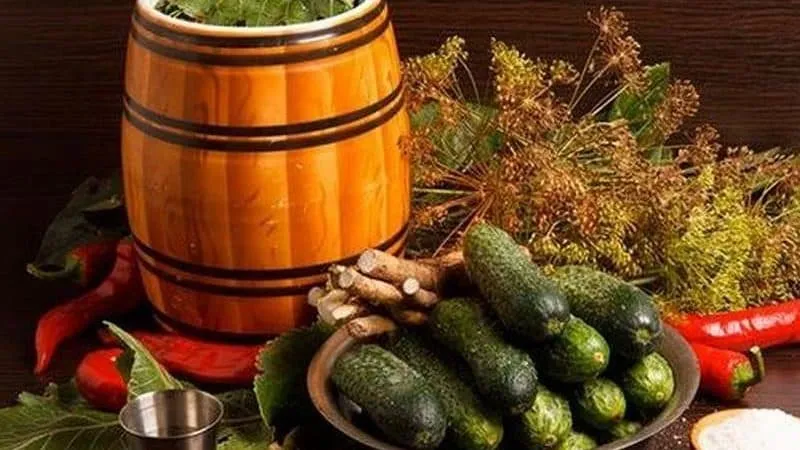
Clean and chop roots, leaves, and spices. Boil the required water amount separately.
- When water boils, add salt and stir until completely dissolved.
- Cool the brine and strain through a sieve.
- Rub barrel walls with a garlic clove.
- Layer spices and herbs at the bottom.
- Pack cucumbers vertically, tightly together.
- Alternate cucumber layers with herb/spice layers until the barrel is full.
- Pour strained brine over the cucumbers, covering completely.
- Seal with a clean lid and place a weight (like a heavy stone) on top.
Keep the barrel warm for 2-3 days to initiate fermentation, then move to a cool cellar or basement.
Alternative Barrel Cucumber Recipes
Over time, people have enhanced the basic recipe with various spices and techniques. Here are some delicious European variations.
"Simple" Recipe
Perfect for those wanting homemade preserves without lengthy preparation.
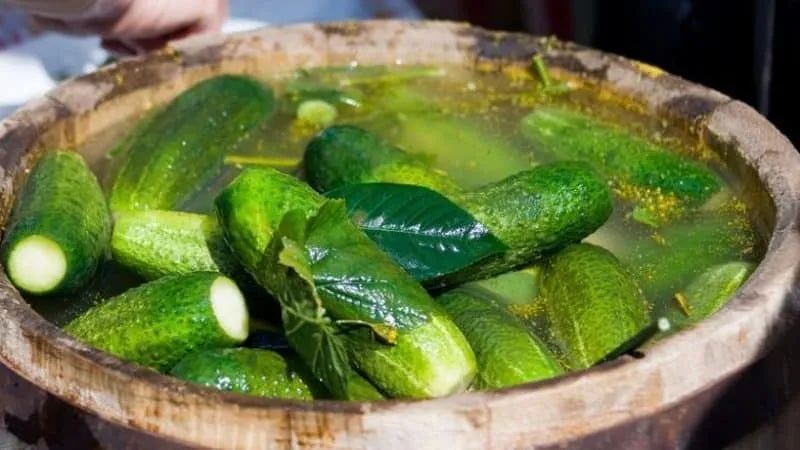
Ingredients:
- Cucumbers – 50 kg;
- Dill with umbels – 700 g;
- Horseradish root – 250 g;
- Garlic – 200 g;
- Parsley/celery roots, cherry leaves – 500 g;
- Salt – 4 kg;
- Water – 40 liters.
Fill the prepared barrel with vertically packed cucumbers, layering with herbs and spices. Top with a final herb layer, seal with a lid and weight. Keep warm for three days before moving to cold storage.
Cold Brine Method
This no-boil method simplifies preparation.
Ingredients:
- Cucumbers – 20 kg;
- Herbs (currant, cherry leaves, dill umbels) – 250 g;
- Garlic – 10 cloves;
- Horseradish root – 200 g;
- Water – 10 liters;
- Coarse salt – 900 g.
Pack prepared cucumbers vertically in the barrel. Dissolve salt in cold water for the brine. Pour over cucumbers, seal, and store cold immediately with a weight on top.
Important. Oak barrels are ideal for fermentation – oak's natural antiseptic properties preserve food beautifully while enhancing flavor and crispness.
"Country-Style" Cucumbers
Remember those delicious fermented cucumbers from grandmother's cellar? The secret lies in organic ingredients, aromatic additions, and "love-infused preparation":
- Cucumbers – 100 kg;
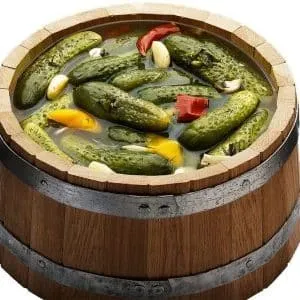
- Garlic – 300 g;
- Chili pepper – 100 g;
- Horseradish root – 500 g;
- Horseradish leaves – 500 g;
- Dill with umbels – 3 kg;
- Celery and parsley leaves – 1 kg;
- Cherry, currant, and oak leaves (combined) – 1 kg;
- Coarse salt – 7 kg;
- Water – 70 liters.
Standard preparation method. For best preservation, meticulously clean all ingredients, removing any spoiled parts. Chop roots, garlic, and leaves; deseed and slice chili peppers. Layer one-third of herbs and spices at the barrel bottom. Add cucumbers, shaking the barrel periodically. Top with remaining herbs and spices. Cover with cold-prepared brine completely. These will keep perfectly in cold storage until spring.
Coriander-Spiced Recipe
Coriander seeds (from Coriandrum sativum) impart a distinctive flavor and aroma.
Ingredients:
- Cucumbers – 100 kg;
- Spice mix (coriander, basil, savory, parsley) – 4-5 kg;
- Garlic – 300 g;
- Salt – 7 kg;
- Water – 70 liters.
Larger cucumbers require stronger brine. Layer spices, herbs, and cucumbers alternately. Cover with brine, seal with a weighted lid. Fermentation begins within 2-3 days; then move to the cellar.
Storage Duration and Conditions
Barrel cucumbers succeed best with proper cellar conditions. Ideal storage requires: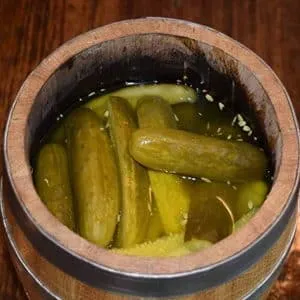
- Temperature below 0°C;
- Good ventilation;
- Wooden pallets for barrel placement (never place directly on floor).
When prepared and stored correctly, these fermented cucumbers keep for a full year. After two years, they lose their optimal flavor and texture.
Fermenting in Plastic Barrels
Plastic barrels have different pros and cons compared to wood. Disadvantages include inability to sterilize properly and poor insulation. However, they're cheaper and easier to clean. Choose food-grade plastic barrels only.
Plastic barrel fermentation differs slightly:
- Soak the plastic barrel in water for two weeks before use.
- Drain and wash with hot baking soda solution.
- Dry thoroughly and cover until ready to fill.
- Prepare cucumbers and spices per your chosen recipe.
- Use cold brine only for plastic barrels.
- Store in cold conditions until consumption.
Plastic-barrel ferments don't last as long as oak-barrel or glass-jar versions, so consume them first.
Tips and Recommendations
Barrel fermentation requires some knowledge and experience. Follow these guidelines for success:
- For vibrant color, briefly dip cucumbers in boiling water then immediately in cold water before fermenting.
- Mustard seeds in brine add distinctive aroma, flavor, and prevent mold.
- Sprinkle mustard powder on the brine surface before sealing to protect against spoilage.
- Add 2-3 cabbage leaves to boost fermentation if starting in cooler conditions.
Conclusion
Every homemaker has her secrets and tricks for perfect preserves. Barrel-fermented cucumbers are no exception. May the invaluable experience passed down through generations help you preserve your garden's bounty successfully.







